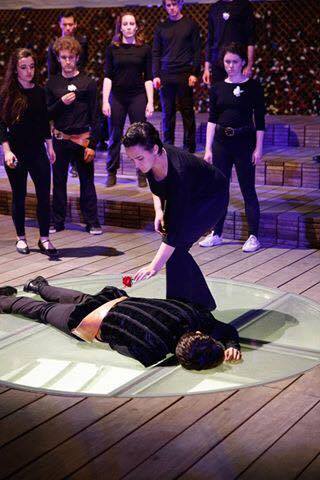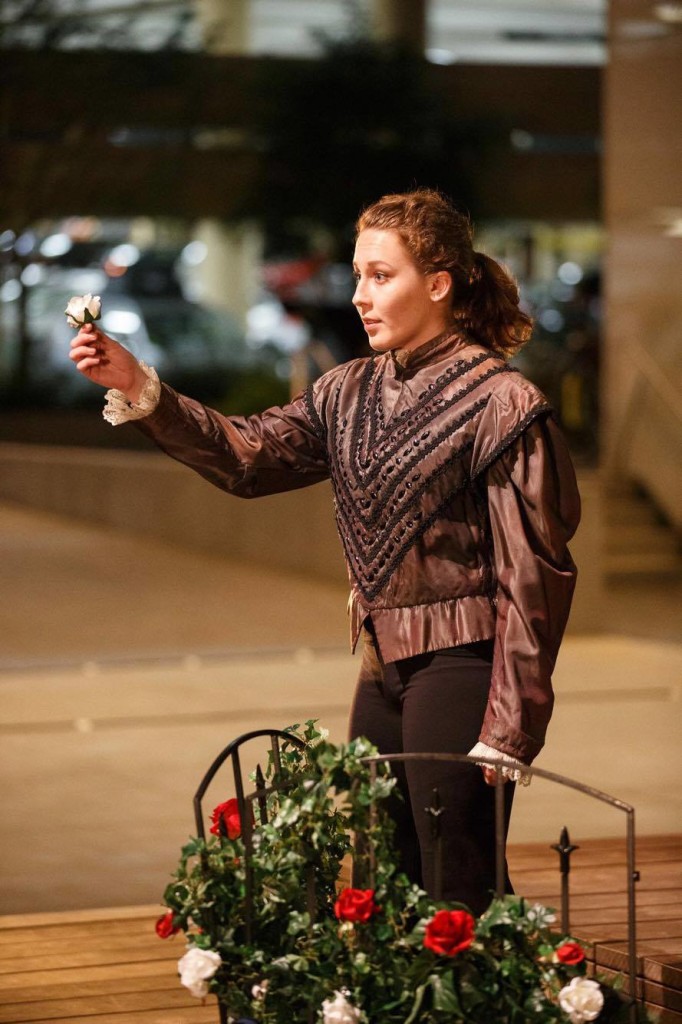
There’s love, violence, anger, machinations, death, despair, marriage, birth, death, sword-fighting, coronation, and more death. You get two dynasties and four plays in three hours. It’s epic, it’s passionate, it’s historical. It’s brisk (they’re not kidding-bring a blanket!), but it’s absolutely worth seeing.
The Stanford Shakespeare Company’s production of “The War of the Roses” took on the monumental task of telling the history of four kings, three generations, and countless deaths in three hours. The story follows the battle for the throne first between the English royal families of York and Lancaster, and then within the York clan. The script was created through a skillful elision on the part of directors Adi Chang ‘18 and Josh Peterson ‘17 between Shakespeare’s often forgotten trilogy of Henry VI Parts 1, 2, and 3 and his much more celebrated work, Richard III to create a single epic play.
And it feels epic. The setting, the open-air center of the McMurtry Building for Art and Art History, gives the actors a high vertical auditorium space, a monolithic wooden rock on which to sit, a tiered stage on which to perform, and a porthole-shaped floorlight with which to work. When the four major players come to take the stage, they stare straight out into the audience and dare you to question their power. The Duke of York (Heather Connolly, ‘18) makes his opening declaration with the self-assurance of your least favorite Washington politician, and you feel the stakes. These are men of power, and they’re in the game to win.
The complicated plot begins with the death of King Henry V and the planned coronation of Henry VI, played with a stunning sensitivity by Kevin Heller ‘16, of the House of Lancaster. His claim to the throne is soon challenged by the Duke of York, of the House of York. When York discovers that Henry has agreed to marry Margaret of Anjou, acted with Kathryn Hepburn-like poise and hauteur by Fiona Maguire (‘19), on condition of forfeiting lands to France and accepting no offered dowry, he begins to revolt in earnest.

York is aided by the sturdy Duke of Buckingham, played with great constancy by Anton de Leon ‘18, and his four sons, Edward (Noah Bennett, ‘19), George (Matthew Libby, ‘17), Rutland (Francesca Lupia, ‘19), and Richard (Louis McWilliams, ‘16). They oppose Henry’s, or rather, Queen Margaret’s forces — Maguire’s powerful presence shadows her quiet husband and it is she who leads his campaign. They include the fiery John Talbot (an exceptional Emma Rothenberg ‘19), the Duke of Somerset (Sarah Mergen, ‘19), Stanley, Duke of Suffolk (a solid Jake Goldstein, ‘18), and young Edward of Lancaster (Eva Borgwardt, ‘19). The two warring houses are differentiated through costuming choices that make it obvious who comes from which house — the Lancasters in red, the Yorks in brown or white.
The plot follows the revolt of York, the growing power of Queen Margaret and parallel growing irrelevance of her husband Henry VI, who shows no interest in waging war, and an insurrection by Joan of Arc. Many sword fights are had, York and Margaret both show their brutality, and by the end of the first act the floor has been littered with bodies several times over. The ruthlessness of the men and women in this act can be shocking. Though it is Talbot who menaces young Rutland of the Yorks saying, “until I root out their accursed line and leave not one alive, I live in Hell,” the sentiment could come from anyone in this act. Life in this political world is nasty, brutish, and short.
Short in many ways. Chang and Peterson eviscerated the scripts of Henry VI in order to make three plays fit into one act, with some pieces of Richard woven in as well. I’ve read all of the Henry VI plays, and I was mightily impressed at their editing choices; they kept the plot, the fight sequences, the few good monologues, and did away with most of the rest. Though the first act of “The War of the Roses” did still feel long, their editing work on the whole is to be commended. Their directorial choices were also strong, as they made the rivalry between houses clear through beautiful oppositional stage pictures and parallelisms. At one point, one soldier attempts to loot a body he killed only to discover that it was his father. Across the stage, another soldier discovers the body he is looting to be that of his son. Between the two stands Henry, lamenting this universal fraternal strife. The moment is poignant and forces the audience to consider how we could become so mad with bloodlust as to kill even our own brethren.
The second act of “The War of the Roses” does feel distinct from the first. Richard III is a tighter play than Henry VI - a personal not a political drama. The strong continuity of colors and staging that defined the first act was not present in the second, and the artistic vision does not always feel consistent. But, as the art that the directors had to work with was not continuous in style, I was impressed that, in spite of this textual difference, they were able to make the plot and the thematic arc feel continuous.

This act deals more with micro-, not macro-level relationships, and those nuanced interactions between the members of the house of York are deftly performed, though they each feel too brief. To make Richard III the length of a single act, Chang and Peterson needed to make serious cuts. The audience occasionally feels it in the shortness of the scenes or the sudden presence of unexplained characters. The seduction of Lady Anne (Davis Leonard, ‘19) is expertly done, and the murder of George is hilariously executed, but some of the other great dialogues of this play feel conspicuously absent.
But the play works, on the whole, due to the talented performances of its actors. Louis McWilliams is capering, aggressive, and truly detestable as Richard III, Matthew Libby is perfectly morally torn as George, duke of Clarence, and Sarah Mergen is appropriately insecure and secure in turns as she transitions from being the low Lady Grey to high Queen Elizabeth. Standout minor roles in this act include Eva Borgwardt as the best comic murderer I’ve seen in years and Fiona Maguire as the “she’s-not-dead-yet” Queen Margaret of Anjou. By the resolution of the play, after the characters each discarded their roses of family affiliation on the (SPOILERS) dead body of Richard III and the lights came up, I was very impressed. This production was a leviathan, and for being a text inherently mismatched in tone it presented a clear throughline in plot and theme.
The thematic arc of the play was aided by solid tech. The lights were effective and worked well with the limitations of the space and the time of day. A subtle throbbing sound effect underscored key moments of the play and heightened the tension in a delicious way. Sam Reamer (’18), assisted by Rachel Jorgensen (’19), Emma Rothenberg (’19), Kaya McRuer (’17), and Eli Margolin (’17), deserve special praise for their thorough and evocative costuming, especially in the first act. Basic blacks were rendered specific by color-coded medieval vests for men and capes for women, and red and white roses further distinguished one family from another. This clear breakdown in family loyalties helped those in the audience who were confused remember who is fighting for whom. The costuming became a less helpful identifier in the second act. This accurately reflected the fact that personal loyalties of the characters have become less clear-cut, but nonetheless did leave the audience at times confused as to who certain characters were.
Yes, it was not perfect. Some aspects of the staging and set in the first act were more effective than others. I understood the use of a staircase landing, which created height in the space and displayed “severed” heads, but I was ultimately frustrated by it, as I had to crane my head each time it was used to see the action and disconnect from the events onstage. The stake used to burning of Joan of Arc was also slightly bizarre, as it was painted metallic silver and surrounded by curled silver wire, and contrasting jarringly with the rest of the simple wooden set.
However, most of “The War of the Roses” is exceptional. Some of it is great, some is good, and at its worst it suffers from a lack of character or relationship clarity. Chang and Peterson were able to cut and paste a sprawling political epic together with an intimate personal drama in a clear, exciting manner that makes an audience member reflect on themselves and their world. Sitting slightly numb (it’s cold out there!) in my folding chair after the show, I asked myself, why do we war? Is war inevitable? How can I stop the cycle of vengeance?
Now that’s the power of good art. Come see the Stanford Shakespeare Company’s “The War of the Roses.” Bring a blanket, bring a friend. Bring two.
Photos courtesy of Frank Chen
